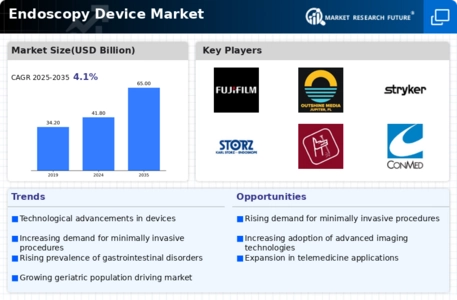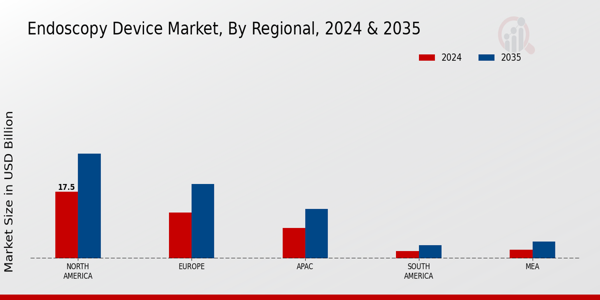Market Trends
Key Emerging Trends in the Endoscopy Devices Market
Endoscopy device market is witnessing significant growth due to continuous technological advancements, including high-definition imaging, 3D visualization, and miniaturization of endoscopic instruments, leading to improved diagnostic accuracy, procedural efficacy, and patient outcomes. The increasing preference for minimally invasive procedures is driving demand for endoscopy devices, as they offer benefits such as reduced patient discomfort, shorter recovery times, and lower healthcare costs compared to traditional surgical interventions. There is a growing expansion of endoscopic indications beyond traditional gastroenterology applications to include specialties such as pulmonology, urology, gynecology, and ENT (ear, nose, and throat), driving market growth and diversification of endoscopy device usage.
The emergence of disposable endoscopes is revolutionizing endoscopy practice by offering single-use, sterile devices that eliminate the risk of cross-contamination, reduce infection rates, and improve procedural efficiency, driving adoption in healthcare settings. Wireless capsule endoscopy, which utilizes ingestible camera capsules to visualize the gastrointestinal tract, is gaining popularity for its non-invasive nature, patient comfort, and ability to diagnose conditions such as Crohn's disease, celiac disease, and small bowel tumors. The integration of artificial intelligence (AI) algorithms into endoscopy devices for image analysis, lesion detection, and real-time decision support is enhancing diagnostic accuracy, reducing procedural variability, and improving workflow efficiency in endoscopic procedures. Therapeutic endoscopy procedures, such as endoscopic mucosal resection (EMR), endoscopic submucosal dissection (ESD), and endoscopic retrograde cholangiopancreatography (ERCP), are expanding the scope of endoscopy device usage for the treatment of gastrointestinal disorders and malignancies.
The adoption of telemedicine and remote consultations for endoscopic evaluation, pre-procedural planning, and post-procedural follow-up is expanding access to specialized endoscopy services, particularly in underserved rural areas and during public health emergencies. With the growing emphasis on infection control in healthcare settings, endoscopy device manufacturers are developing devices with disposable components, sterilization technologies, and infection prevention protocols to minimize the risk of healthcare-associated infections (HAIs). Regulatory compliance and quality assurance are paramount in the endoscopy device market, with manufacturers investing in research and development, clinical trials, and regulatory approvals to ensure product safety, efficacy, and adherence to regulatory standards. The endoscopy device market is experiencing global expansion, with emerging markets in regions such as Asia-Pacific, Latin America, and the Middle East presenting untapped opportunities for market growth due to increasing healthcare infrastructure development and rising demand for minimally invasive procedures.
Patient-centric care models, including shared decision-making, patient education, and informed consent, are driving demand for endoscopy devices that prioritize patient comfort, safety, and satisfaction, fostering trust and engagement in endoscopic procedures. Training and education initiatives for endoscopy device users, including physicians, nurses, and technicians, are essential for ensuring procedural competency, adherence to best practices, and continuous quality improvement in endoscopic practice. Endoscopy devices are increasingly integrated into cancer screening programs for early detection and surveillance of gastrointestinal cancers, such as colorectal cancer, gastric cancer, and esophageal cancer, contributing to improved cancer outcomes and mortality reduction. Collaborative research collaborations between academia, industry, and healthcare organizations are driving innovation and advancement in endoscopy device development, leading to the development of novel technologies, procedural techniques, and treatment modalities to address unmet clinical needs in endoscopy practice.















Leave a Comment